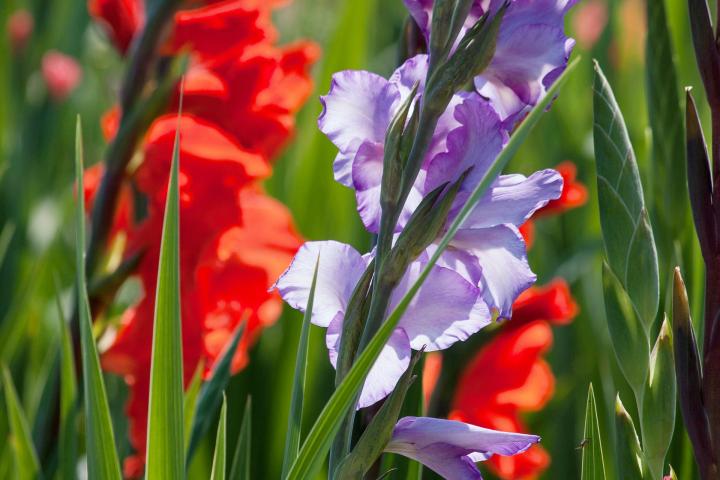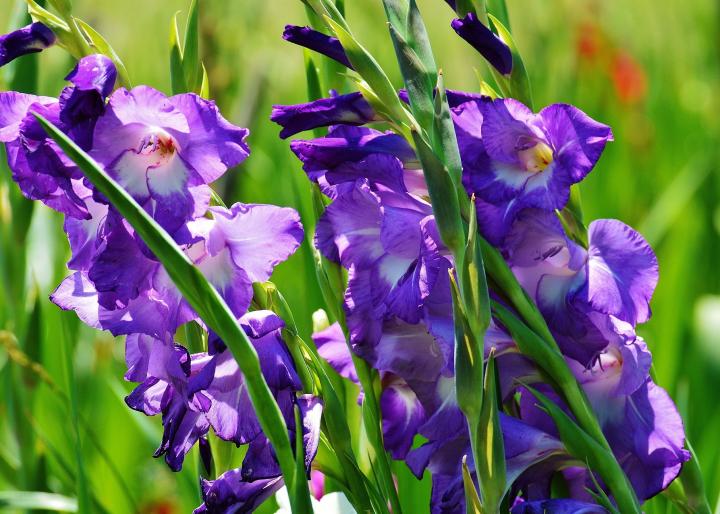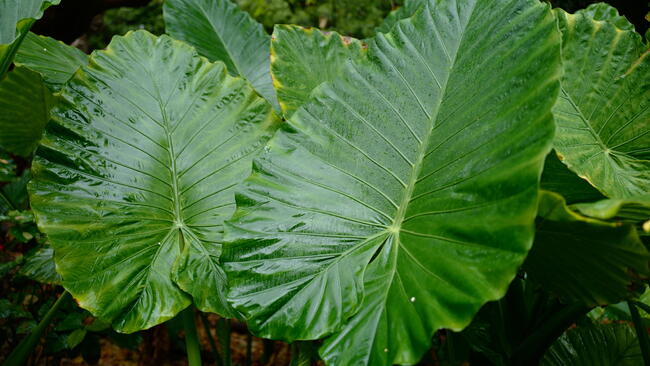
Plant gladiolus to enjoy bold blooms and beautiful summer bouquets.
Read Next
Types
Gladioli come in a variety of sizes and colors, with the most popular being part of the following hybrid groups:
- Grandiflora Hybrids: These are the classic gladioli that produce a plentiful amount of large (5- to 6-inch) blooms in a range of colors. The plants produce flower stalks that reach up to 4 feet in height and are winter hardy to Zone 7.
- Dwarf Grandiflora Hybrids: These miniature glads are an excellent choice for containers and cutting gardens, as their flowers are about half the size of Grandifloras, and their shorter stalks don’t typically require staking. They are also winter hardy to Zone 7. Glamini gladioli are included in this group; they are pest-resistant and will bloom in full sun or partial shade.
- Nanus Hybrids: Hardy to Zone 5, these smaller gladioli look a lot like Grandifloras, but do not produce as many flowers. They tend to grow no larger than about 2 feet in height, which makes them perfect for containers or small spaces.
Some specific gladiolus varieties of note include:
- ‘Black Star’ has deep purple-red blooms
- ‘Candyman’ for its beautiful, deep pink flowers
- ‘Costa’ sports ruffled flowers in blue-purple
- ‘Dream’s End’ makes a good background plant because its flower spike is up to 3 feet tall (and it has pretty light orange flowers with large yellow centers)
- ‘Fun Time’ has yellow flowers edged with red
- ‘Green Time’ for its unusual lime-green flowers
- ‘Prins Claus’ has white flowers with splashes of pink on its petals
- ‘Priscilla’ produces off-white flowers with a yellow center and a pink edge
Gardening Products
More Like This
We're not sure what material you are considering as a greenhouse sheet. Ideally, a breathable fabric is best, such as burlap, bedsheets, row covers, newspapers, a light blanket, etc.; remove the fabric during the day when temperatures warm up enough (most fabrics don't allow enough light in, so you'll need to remove them during daytime.)
You can use clear, flexible plastic, but it will encourage condensation inside, which might freeze during the night, and any plant part that is touching it (use stakes etc. to prop up the plastic so that it doesn't touch the plants); you must remember to remove it during the day or temperatures inside can get too hot for the plant. The same goes for a cold frame or similar--open it periodically during the day to allow air circulation and condensation to escape.
Frost protection is needed for an unexpected late spring frost, or an unexpected early fall frost. However, if you live in USDA hardiness plant zones 6 and colder, you should dig up the corms in fall for winter storage; gardeners in Zones 7 or warmer can instead cover the area with a thick layer of straw or similar to provide winter protection, leaving the corms in the soil over winter.
Hmm. There are insects, such as thrips, or diseases that can cause deformed flowers, but usually there are symptoms on the leaves as well. Do you think it might be a nutrient deficiency, such as calcium? For more information, you might be interested in this report:
http://ufdc.ufl.edu/UF00067646/00001/5j
It says that a calcium deficiency, which doesn't often show up in leaves unless severe, can affect the flowers, and in certain cases, the petals may curve in, and there might be water-soaked spots on them. The flower spikes may look twisted and, if used as a cut flower in a vase, may fall over once all flowers on the spike are in bloom. If you think this is the case, you might try adding a little ground limestone to the soil.
Although there are several reasons for browning flowers (including pests and diseases), if the edges are brittle, not mushy, then our best guess is that it is likely heat damage--especially if the leaves are showing similar symptoms. (Symptoms of heat stress can appear in several ways, depending on the plant, growth stage, and circumstance.) In high heat, water more than the average 1 inch per week. Mulch will help keep the soil moist. You might provide a temporary screen to filter out some direct sun during excessive heat. Some varieties of glads are more heat tolerant than others.
- « Previous
- 1
- 2
- …
- 10
- Next »












Comments